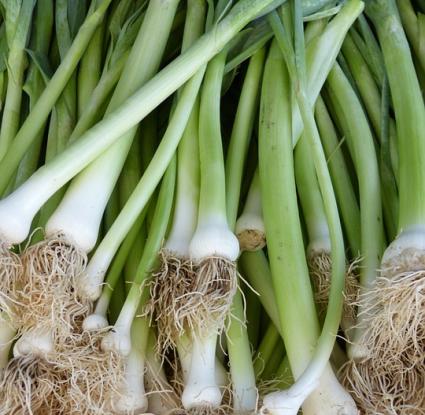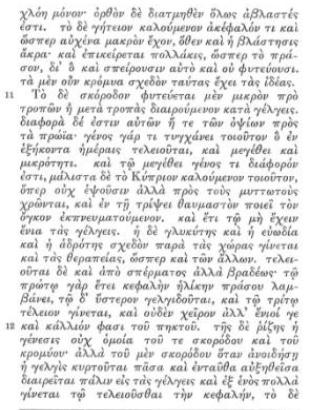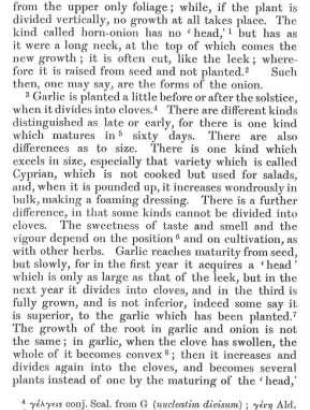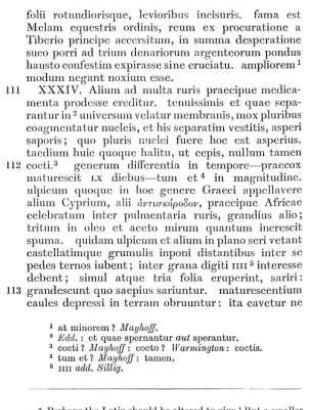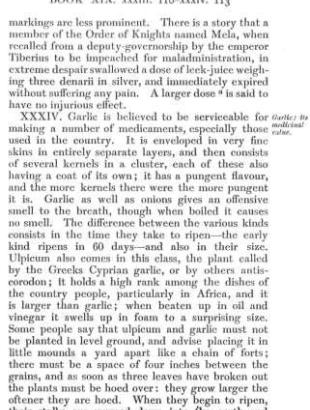A variety of leek (or garlic) which is found in ancient written sources under the geographical name ‘Kyprion'.
Name - Origin
A variety of leek (or garlic) (Ulpicum)
Scientific name: Allium ampeloprasum (Mezzabotta 2000, 235).
The written sources reveal three elements linked to the preparation of the product for consumption: firstly, it is not eaten cooked; secondly, it is not eaten on its own but mixed with other ingredients; and thirdly, in order to obtain volume and a mousse texture it must be mixed with oil and vinegar (Theophrastus (1992), vol. 2, 90-91, 7.4.11; Pliny (1993), vol. 5, 492-493, 19.112).
Functional and symbolic role
The name 'Kyprion' is not necessarily linked to the place of production, just as the geographical designation of a species does not necessarily correspond to its geographical origin. Assuming that the Cypriots consumed this species, the details recorded by ancient writers about its importance in the Cypriot diet are minimal. The only clue that Theophrastus gives us (Theophrastus, Περί Φυτών Ιστορίαι, 7.4.11, 90-91) is that it was consumed as part of a salad along with honey and cheese (see Supplementary Information).
Additional information and bibliography
Two ancient passages refer to "Kyprion" or antiskorodon: Theophrastus (4th - 3rd c. BC) in his work «Περί Φυτών Ιστορίαι» mentions "Kyprion" as a kind of garlic (KEIM.1). Pliny (1st century AD) in his work «Φυσική Ιστορία» refers to 'ulpicum' which he says the Greeks call 'Kyprion' and others 'antiskorodon'. He also mentions that it is consumed mostly in rural areas, mainly in Africa. Pliny makes suggestions for the cultivation of both 'antiskorodos' and garlic, for example that it is best to plant them in raised ground rather than directly on the surface (TEXT 2). Some of the information which Pliny records (for example, that when antiskorodon is mixed with oil and vinegar, its volume is exceptional) seems to have been taken from Theophrastus who wrote his text four centuries earlier (Michaelides 1998, 31). The 'ulpicum' which Pliny equates with 'kyprion' or antiskorodon occurs 31 times in Latin sources according to Mezzabotta (2000, 230). Mezzabotta examines the issue of equating 'ulpicum' with a species now identified as Allium ampeloprasum (a type of leek) and in common language as 'great-headed garlic'.
Theophrastus, Enquiry into Plants, Loeb Classical Library 79, vol. 2, Hort A. F. (translation) (1980), Harvard University Press, Cambridge.
Pliny, Natural History, Loeb Classical Library, τ. 5, Rackham H. (translation) (1992), Harvard University Press, Cambridge.
Hadjioannou K. (1975), Η Αρχαία Κύπρος εις τας Ελληνικάς Πηγάς, Vol. Α΄-Στ΄, Edition of the Archbishopric of Cyprus, Nicosia.
Mezzabotta M. R. (2000), "What was Ulpicum?", The Classical Quarterly 50,1 (New Series), 230-237.
Michaelides D. (1998), "The Food in Ancient Cyprus", Food and the Traveller-Migration, Immigration, Tourism and Ethnic group, Lysaght P. (ed.), Intercollege Press, Nicosia.
Natasa Charalambous, Argyro Xenophontos

